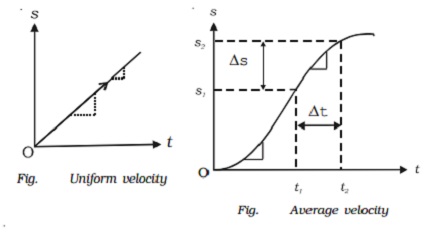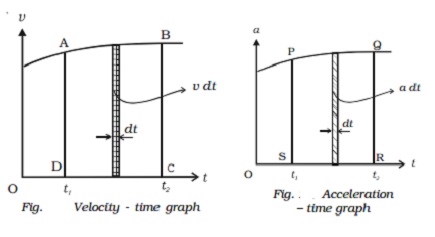Chapter: 11th 12th std standard Class Physics sciense Higher secondary school College Notes
Motion in one dimension (rectilinear motion)

Motion
in one dimension (rectilinear motion)
The motion along a straight line is known as
rectilinear motion. The important parameters required to study the motion along
a straight line are position, displacement, velocity, and acceleration.
1.Position,
displacement and distance travelled by the particle
The motion of a particle can be described if
its position is known continuously with respect to time.
The total length of the path is the distance
travelled by the particle and the shortest distance between the initial and
final position of the particle is the displacement.
The
distance travelled by a particle, however, is different from its displacement
from the origin. For example, if the particle moves from a Fig 2.1 Distance and
displacement point O to position P1 and then to position P2, its displacement at the
position P2 is ? x2
from the origin but, the distance travelled by the particle is x1+x1+x2
= (2x1+x2) (Fig ).

The distance travelled is a scalar quantity and
the displacement is a vector quantity.
2 Speed and velocity
Speed
It is
the distance travelled in unit time. It is a scalar quantity.
Velocity
The velocity of a particle is defined as the
rate of change of displacement of the particle. It is also defined as the speed of the particle in a given direction. The velocity is a
vector quantity. It has both magnitude and direction.
Velocity = displacement / time taken
Its unit is m s-1
and its dimensional formula is LT-1
A particle is said to move with uniform
velocity if it moves along a fixed direction and covers equal displacements in
equal intervals of time, however small these intervals of time may be.
In a displacement
- time graph, t (Fig. ) the slope is constant at
all the points, when the particle moves with uniform velocity.
Non uniform or variable velocity
The velocity is variable (non-uniform), if it covers unequal
displacements in equal intervals of time or if the direction of motion changes
or if both the rate of motion and the direction change.

Average velocity
Let s1 be the displacement of a body in time t 1
and s2 be itsdisplacement in time t 2 (Fig.).
The average velocity during the timeinterval (t2
? t1) is defined as
vaverage = change in displacement /
change in time
= s2-s1 / t2-t1 = ∆s / ∆t
From the graph, it is found that the slope of the curve varies.
Instantaneous velocity
It is the velocity at any given instant of time or at any given
point of its path. The instantaneous velocity v is given by
v= Lim ∆s / ∆t = ds / dt
3. Acceleration
If the magnitude or the direction or both of the velocity changes
with respect to time, the particle is said to be under acceleration.
Acceleration of a particle is defined as the rate of change of
velocity. Acceleration is a vector quantity.
Acceleration = change in velocity / time taken
If u is the initial velocity and v, the final velocity of the
particle after a time t, then the acceleration,
A = ( v-u )/ t
Its unit is m s−2 and its dimensional formula is LT−2.
The instantaneous acceleration is , a= dv/dt = d/dt(ds/dt) = d2s/dt2
Uniform acceleration
If the velocity changes by an equal amount in equal intervals of
time, however small these intervals of time may be, the acceleration is said to
be uniform.
Retardation or deceleration
If the velocity decreases with time, the acceleration is negative.
The negative acceleration is called retardation or deceleration.
Uniform motion
A particle is in uniform motion when it moves
with constant velocity (i.e) zero acceleration.
4 Graphical representations
The graphs provide a convenient method to
present pictorially, the basic informations about a variety of events. Line
graphs are used to show the relation of one quantity say displacement or
velocity with another quantity such as time.
If the displacement, velocity and acceleration
of a particle are plotted with respect to time, they are known as,
1. displacement ? time graph (s - t graph)
2. velocity ? time graph (v - t graph)
3. acceleration ? time graph (a - t graph)
Displacement ? time graph When the displacement
of the particle is plotted as a function of time, it is displacement - time graph.
As v = ds/dt , the slope of the s - t graph at
any instant gives the velocity of the particle at that instant. In Fig. the
particle at time t1, has a positive velocity, at time t2, has zero velocity and
at time t3, has negative velocity.

Velocity
? time graph
When the velocity of the particle is plotted as
a function of time, it is velocity-time graph.
As a = dv/dt , the slope of the v ? t curve at
any instant gives the acceleration of the particle (Fig. ).
But v=ds/dt or
Ds = v dt
If the displacements are s1 and s2
in times t1 and t2 then
∫12ds = ∫ t1t2
vdt
S2-s1 = ∫t1t2vdt
= area ABCD
The area under the v ? t curve, between the
given intervals of time, gives the change in displacement or the distance
travelled by the particle during the same interval.

Acceleration
? time graph
When the acceleration is plotted as a function
of time, it is acceleration ? time graph (Fig. ).
A=dv/dt
Or dv = adt
If the velocities are v1 and v2
at times t1 and t2 respectively, then
∫v1v2 dv = ∫t1t2
a dt
V2-v1 = ∫t1t2adt
= area PQRS
The area under the a ? t curve, between the
given intervals of time, gives the change in velocity of the particle during
the same interval. If the graph is parallel to the time axis, the body moves
with constant
acceleration.
5 Equations of motion
For uniformly accelerated motion, some simple
equations that relate displacement s, time t,
initial velocity u, final velocity v and acceleration a are obtained.
(i) As acceleration of the body at any instant
is given by the first derivative of the velocity with respect to time,
A=dv/dt
or dv=adt
If the velocity of the body changes from u to v
in time t then from the above equation.
∫uvdv = ∫0t
adt = a∫0tdt =
[v]uv = a[t]0t
v-u =at
v=u+at
(ii) The velocity of the body is given by the first
derivative of the displacement with respect to time.
v=ds/dt
ds=vdt
Since v = u + at, ds = (u + at) dt
The distance s covered in time t is,
∫0sds = ∫0tudt+∫0tatdt
S=ut+1/2at2
(iii) The acceleration is given by the first derivative of velocity
with respect to time. (i.e)
A=dv/dt=dv/ds.ds/dt = dv/ds.v
Ds=1/a.vdv
Therefore,
∫0sds =∫uv(vdv)/a
S=1/2a(v2-u2)
Or
2as=v2-u2
v2=u2+2as
The equations (1), (2) and (3) are called equations of motion.
Expression for the distance travelled in nth
second
Let a body move with an initial velocity u and travel along a straight
line with uniform acceleration a.
Distance travelled in the nth second of motion is,
Sn = distance travelled during first n seconds ?
distance
travelled during (n ?1) seconds
Distance travelled during n seconds
Dn=un+1/2an2
Distance travelled during (n -1) seconds
D(n-1) = u(n+1) + 1/2a(n-1)2
the distance travelled in the nth second = Dn− D(n
?1)
Sn = (un+1/2an2).[u(n-1)+1/2a(n-1)2]
Sn=u+1/2a(2n-1)
Special Cases
Case (i) : For downward motion
For a particle moving downwards, a = g, since the particle moves in the
direction of gravity.
Case (ii) : For a freely falling body
For a freely falling body, a = g and u = 0,
since it starts from rest.
Case (iii) : For upward motion
For a particle moving upwards, a = - g, since the particle
moves against the gravity.
Related Topics